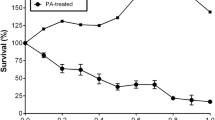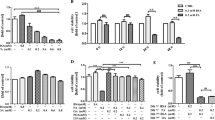Abstract
Saturated fatty acids have been considered major contributing factors in type 2 diabetes, whereas unsaturated fatty acids have beneficial effects for preventing the development of diabetes. However, the effects of polyunsaturated fatty acids in pancreatic β cells have not been reported. Here, we examined the effects of arachidonic acid (AA) on palmitic acid (PA)-mediated lipotoxicity in clonal HIT-T15 pancreatic β cells. AA prevented the PA-induced lipotoxicity as indicated by cell viability, DNA fragmentation and mitochondrial membrane potential, whereas eicosatetraynoic acid (ETYA), a non-metabolizable AA, had little effect on PA-induced lipotoxicity. In parallel with its protective effects against PA-induced lipotoxicity, AA restored impaired insulin expression and secretion induced by PA. AA but not ETYA increased intracellular triglyceride (TG) in the presence of PA compared with PA alone, and xanthohumol, a diacylglycerol acyltransferase (DGAT) inhibitor, reversed AA-induced protection from PA. Taken together, our results suggest that AA protects against PA-induced lipotoxicity in clonal HIT-T15 pancreatic β cells, and the protective effects may be associated with TG accumulation, possibly through sequestration of lipotoxic PA into TG.









Similar content being viewed by others
References
Saini V (2010) Molecular mechanisms of insulin resistance in type 2 diabetes mellitus. World J Diabetes 1:68–75
Poitout V, Robertson RP (2008) Glucolipotoxicity: fuel excess and β cell dysfunction. Endocr Rev 29:351–366
Wakil SJ, Abu-Elheiga LA (2009) Fatty acid metabolism: target for metabolic syndrome. J Lipid Res 50(Suppl): S138–S143
Schaffer JE (2003) Lipotoxicity: when tissues overeat. Curr Opin Lipidol 14:281–287
Zhou YP, Grill VE (1995) Long-term exposure of rat pancreatic islets to fatty acids inhibits glucose-induced insulin secretion and biosynthesis through a glucose fatty acid cycle. J Clin Invest 93:870–876
Shimabukuro M, Zhou YT, Levi M, Unger RH (1998) Fatty acid-induced beta cell apoptosis: a link between obesity and diabetes. Proc Natl Acad Sci USA 95:2498–2502
Morgan NG (2009) Fatty acid and beta cell toxicity. Curr Opin Clin Nutr Metab Care 12:117–122
Eitel K, Staiger H, Brendel MD, Brandhorst D, Bretzel RG, Häring HU, Kellerer M (2002) Different role of saturated and unsaturated fatty acids in β-cell apoptosis. Biochem Biophys Res Commun 299:853–856
Mu YM, Yanase T, Nishi Y, Tanaka A, Saito M, Jin C-H, Mukasa C, Okabe T, Nomura M, Goto K, Nawata H (2001) Saturated FFAs, palmitic acid and stearic acid, induce apoptosis in human granulose cells. Endocrinology 142:3590–3597
Buschbeck M, Ghomashchi F, Gelb MH, Watson SP, Borsch-Haubold AG (1999) Stress stimuli increase calcium-induced arachidonic acid release through phosphorylation of cytosolic phospholipase A2. Biochem J 344:359–366
Brash AR (2001) Arachidonic acid as a bioactive molecule. J Clin Invest 107:1339–1345
Choi SE, Jung IR, Lee YJ, Lee SJ, Lee JH, Kim Y, Jun H-S, Lee K-W, Park CB, Kang Y (2011) Stimulation of lipogenesis as well as fatty acid oxidation protects against palmitate-induced INS-1 β-cell death. Endocrinology 152:816–827
Listenberger LL, Han X, Lewis SE, Cases S, Farese RV Jr, Ory DS, Schaffer JE (2003) Triglyceride accumulation protects against fatty acid-induced lipotoxicity. Proc Natl Acad Sci USA 100:3077–3082
Wiesenfeld PW, Babu US, O’Donnell MW (2001) Effects of long-chain fatty acids in the culture medium on fatty acid composition of WEHI-3 and J774A.1 cells. Comp Biochem Physiol B Biochem Mol Biol 128:123–134
Folch J, Lees M, Sloane Stanley GH (1957) A simple method for the isolation and purification of total lipids from animal tissues. J Biol Chem 226:497–509
Kelpe CL, Moore PC, Parazzoli SD, Wicksteed B, Rhodes CJ, Poitout V (2003) Palmitate inhibition of insulin gene expression is mediated at the transcriptional level via ceramide synthesis. J Biol Chem 278:30015–30021
Maedler K, Oberholzer J, Bucher P, Spinas GA, Donath MY (2003) Monounsaturated fatty acids prevent the deleterious effects of palmitate and high glucose on human pancreatic β-cell turnover and function. Diabetes 52:726–733
Keane DC, Takahashi HK, Dhayal S, Morgan NG, Curi R, Newsholme P (2011) Arachidonic acid actions of functional integrity and attenuation of the negative effects of palmitic acid in a clonal pancreatic β cell line. Clin Sci 120:195–206
Elsner M, Gehrmann W, Lenzen S (2011) Peroxisome-generated hydrogen peroxide as important mediator of lipotoxicity in insulin producing cells. Diabetes 60:200–208
Listenberger LL, Ory DS, Schaffer JE (2001) Palmitate-induced apoptosis can occur through a ceramide-independent pathway. J Biol Chem 276:14890–14895
Itoh Y, Kawamata Y, Harada M, Kobayashi M, Fujii R, Fukusumi S, Ogi K, Hosoya M, Tanaka Y, Uejima H, Tanaka H, Maruyama M, Satoh R, Okubo S, Kizawa H, Komatsu H, Matsumura F, Noguchi Y, Shinohara T, Hinuma S, Fujisawa Y, Fujino M (2003) Free fatty acids regulate insulin secretion from pancreatic beta cells through GPR40. Nature 422:173–176
Schnell S, Schaefer M, Schofl C (2007) Free fatty acids increase cytosolic free calcium and stimulate insulin secretion from beta cells through activation of GPR40. Mol Cell Endocrinol 263:173–180
Maedler K, Spinas GS, Dyntar D, Moritz W, Kaiser N, Donath MY (2001) Distinct effects of saturated and monounsaturated fatty acids on β-cell turnover and function. Diabetes 50:69–76
Yamashita T, Eto K, Okazaki Y, Yamashita S, Yamauchi T, Sekine N, Nagai R, Noda M, Kadowaki T (2004) Role of UCP-2 up-regulation and TG accumulation in impaired glucose-stimulated insulin secretion in a cell lipotoxicity model overexpressing SREBP-1c. Endocrinology 145:3566–3577
Briaud I, Harmon JS, Kelpe CL, Segu VBG, Poitout V (2001) Lipotoxicity of the pancreatic β-cell is associated with glucose-dependent esterification of fatty acids into neutral lipids. Diabetes 50:315–321
Reshef L, Olswang Y, Cassuto H, Blum B, Colleen M, Croniger CM, Kalhan SC, Tilghman SM, Hanson RW (2003) Glyceroneogenesis and the triglyceride/fatty acid cycle. J Biol Chem 278:30413–30416
Cnop M, Hannaert JC, Hoorens A, Eizirik DL, Pipeleers DG (2001) Inverse relationship between cytotoxicity of free fatty acids in pancreatic islet cells and cellular triglyceride accumulation. Diabetes 50:1771–1777
Genevieve C, Sparagna DL, Hickson-Bick L, Maximilian B, Jeanie BM (2000) A metabolic role for mitochondria in palmitate-induced cardiac myocyte apoptosis. Am J Physiol Heart Circ Physiol 279:H2124–H2132
Kwon G, Pappan KL, Marshall CA, Schaffer JE, McDaniel ML (2004) cAMP dose-dependently prevents palmitate-induced apoptosis by both protein kinase A- and cAMP-guanine nucleotide exchange factor-dependent pathways in β-cells. J Biol Chem 279:8938–8945
Stubbs CD, Smith AD (1984) The modification of mammalian membrane polyunsaturated fatty acid composition in relation to membrane fluidity and function. Biochim Biophys Acta 779:89–137
Acknowledgments
This study was supported by grants from 21C frontier program “The center for biological modulators” funded by Ministry of Science and Technology in Korea.
Author information
Authors and Affiliations
Corresponding author
Rights and permissions
About this article
Cite this article
Cho, Y.S., Kim, C.H., Kim, K.Y. et al. Protective effects of arachidonic acid against palmitic acid-mediated lipotoxicity in HIT-T15 cells. Mol Cell Biochem 364, 19–28 (2012). https://doi.org/10.1007/s11010-011-1200-z
Received:
Accepted:
Published:
Issue Date:
DOI: https://doi.org/10.1007/s11010-011-1200-z




